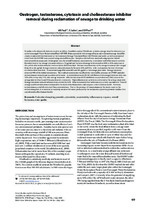| dc.contributor.author | Faul, A.K. | |
| dc.contributor.author | Julies, E. | |
| dc.contributor.author | Pool, Edmund John | |
| dc.date.accessioned | 2017-09-12T08:03:43Z | |
| dc.date.available | 2017-09-12T08:03:43Z | |
| dc.date.issued | 2013 | |
| dc.identifier.citation | Faul, A.K. et al. (2013). Oestrogen, testosterone, cytotoxin and cholinesterase inhibitor removal during reclamation of sewage to drinking water. Water SA, 39(4): 499 - 506 | en_US |
| dc.identifier.issn | 0378-4738 | |
| dc.identifier.uri | http://dx.doi.org/10.4314/wsa.v39i4.8 | |
| dc.identifier.uri | http://hdl.handle.net/10566/3188 | |
| dc.description.abstract | Namibia is the driest sub-Saharan country in Africa. Namibia’s capital, Windhoek, reclaims sewage water for domestic use at the Goreangab Water Reclamation Plant (GWRP). Risks associated with sewage effluent and reclaimed sewage should be closely monitored; therefore water at the Gammams Sewage Treatment Plant (GSTP) inlet and outlet, as well as reclaimed water from the GWRP, were assayed using selected bioassays. Samples collected were analysed using enzyme-linked immunosorbent-assays and chromogenic tests for steroid hormones, neurotoxicity, cytotoxicity and inflammatory activity. Estradiol level at the sewage treatment inlet was 78 pg/mℓ and the treated sewage level showed an 83% to 95% reduction in this, while after reclamation the level was below detection limit. Estrone concentrations at the sewage treatment inlet ranged from 10 to 161 pg/mℓ. Sewage treatment reduced estrone by between 85% and 92%. After reclamation the level of estrone was below detection limit. Testosterone ranged between 162 and 405 pg/mℓ at the sewage plant inlet. Sewage treatment removed 96% of the initial testosterone. The residual testosterone was effectively removed by processes in GWRP and after reclamation no testosterone was detected in water. Acetylcholinesterase (AChE) inhibition at the sewage treatment inlet was 50% while it was only 27% after sewage treatment. After reclamation AChE inhibition was not detected. Only water at the sewage inlet in March and February showed cytotoxicity. High inflammatory activity was detected at the sewage plant inlet. Sewage treatment reduced inflammatory activity by 64%. After reclamation low inflammatory activity was induced. Treated sewage used for reclamation tested positive for most of the biomarkers and can pose a risk to human health. However, reclamation successfully removed these contaminants. Due to the presence of contaminants in the intake water at the reclamation plant, it is essential to routinely monitor the water produced by the reclamation plant for potential residues that can adversely affect human health. | en_US |
| dc.language.iso | en | en_US |
| dc.publisher | Water Research Commission | en_US |
| dc.rights | Water SA is an open access journal and all content is available without charge to the user. The content of this journal is licensed under a Creative Commons Attribution Licence. Users are permitted to read, download, copy, distribute, print, search or link to the full texts of the articles in this journal under the terms of this Licence, without asking prior permission from the publisher or the author. The publisher's version of the article may be archived in an online repository, by the author or any other user. | |
| dc.subject | Endocrine disrupting potential | en_US |
| dc.subject | Cytotoxicity | en_US |
| dc.subject | Neurotoxicity | en_US |
| dc.subject | Inflammatory response | en_US |
| dc.subject | Steroid hormones | en_US |
| dc.subject | Water quality | en_US |
| dc.title | Oestrogen, testosterone, cytotoxin and cholinesterase inhibitor removal during reclamation of sewage to drinking water | en_US |
| dc.type | Article | en_US |
| dc.privacy.showsubmitter | FALSE | |
| dc.status.ispeerreviewed | TRUE | |
| dc.description.accreditation | Web of Science | |

